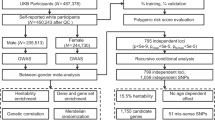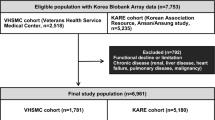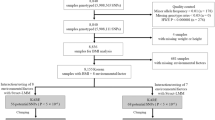Abstract
The contribution of specific molecular-genetic factors to muscle mass variation and sarcopenia remains largely unknown. To identify endogenous molecules and specific genetic factors associated with appendicular lean mass (APLM) in the general population, cross-sectional data from the TwinsUK Adult Twin Registry were used. Non-targeted mass spec-based metabolomic profiling was performed on plasma of 3953 females (mostly dizygotic and monozygotic twins). APLM was measured using dual-energy X-ray absorptiometry (DXA) and genotyping was genome-wide (GWAS). Specific metabolites were used as intermediate phenotypes in the identification of single-nucleotide polymorphisms associated with APLM using GWAS. In all, 162 metabolites were found significantly correlated with APLM, and explained 17.4% of its variation. However, the top three of them (unidentified substance X12063, urate, and mannose) explained 11.1% (P≤9.25 × 10−26) so each was subjected to GWAS. Each metabolite showed highly significant (P≤9.28 × 10−46) associations with genetic variants in the corresponding genomic regions. Mendelian randomization using these SNPs found no evidence for a direct causal effect of these metabolites on APLM. However, using a new software platform for bivariate analysis we showed that shared genetic factors contribute significantly (P≤4.31 × 10−43) to variance in both the metabolites and APLM – independent of the effect of the associated SNPs. There are several metabolites, having a clear pattern of genetic inheritance, which are highly significantly associated with APLM and may provide a cheap and readily accessible biomarker of muscle mass. However, the mechanism by which the genetic factor influences muscle mass remains to be discovered.
Similar content being viewed by others
Log in or create a free account to read this content
Gain free access to this article, as well as selected content from this journal and more on nature.com
or
References
Janssen I, Baumgartner RN, Ross R, Rosenberg IH, Roubenoff R : Skeletal muscle cutpoints associated with elevated physical disability risk in older men and women. Am J Epidemiol 2004; 159: 413–421.
Cruz-Jentoft AJ, Baeyens JP, Bauer JM et al: Sarcopenia: European consensus on definition and diagnosis. Age and Ageing 2010; 39: 412–423.
Doherty TJ : Aging and sarcopenia. J Appl Physiol 2003; 95: 1717–1727.
Karakelides H, Nair KS : Sarcopenia of aging and its metabolic impact. Curr Top Dev Biol 2005; 68: 123–148.
Livshits G, Kato BS, Wilson SG, Spector TD : Linkage of genes to total lean body mass in normal women. J Clin Endocrinol Metab 2007; 92: 3171–3176.
Gjesdal CG, Halse JI, Eide GE, Brun JG, Tell GS : Impact of lean mass and fat mass on bone mineral density: The Hordaland Health Study. Maturitas 2008; 59: 191–200.
Arden NK, Spector TD : Genetic influences on muscle strength, lean body mass, and bone mineral density: a twin study. J Bone Miner Res 1997; 12: 2076–2081.
Hsu FC, Lenchik L, Nicklas BJ et al: Heritability of body composition measured by DXA in the diabetes heart study. Obes Res 2005; 13: 312–319.
Hai R, Pei YF, Shen H et al: Genome-wide association study of copy number variation identified gremlin1 as a candidate gene for lean body mass. J Hum Genet 2012; 57: 33–37.
Guo YF, Zhang LS, Liu YJ et al: Suggestion of GLYAT gene underlying variation of bone size and body lean mass as revealed by a bivariate genome-wide association study. Hum Genet 2013; 132: 189–199.
Livshits G, Malkin I, Moayyeri A, Spector TD, Hammond CJ : Association of FTO gene variants with body composition in UK twins. Ann Hum Genet 2012; 76: 333–341.
Madsen RK, Lundstedt T, Gabrielsson J et al: Diagnostic properties of metabolic perturbations in rheumatoid arthritis. Arthritis Res Ther 2011; 8: 13, R19.
Liu ML, Zheng P, Liu Z et al: GC-MS based metabolomics identification of possible novel biomarkers for schizophrenia in peripheral blood mononuclear cells. Mol Biosyst 2014; 10: 2398–2406.
Merlini L, Vagheggini A, Cocchi D : Sarcopenia and sarcopenic obesity in patients with muscular dystrophy. Front Aging Neurosci 2014; 6: 274.
Sun L, Tan LJ, Lei SF et al: Bivariate genome-wide association analyses of femoral neck bone geometry and appendicular lean mass. PLoS ONE 2011; 6: e27325.
Ran S, Liu YJ, Zhang L et al: Genome-wide association study identified copy number variants important for appendicular lean mass. PLoS One 2014; 9: e89776, PLoS One 2011; 6: e27325.
Moayyeri A, Hammond CJ, Hart DJ, Spector TD : The UK Adult Twin Registry (TwinsUK Resource). Twin Res Hum Genet 2013; 16: 144–149.
Moayyeri A, Hammond CJ, Hart DJ, Spector TD : Effects of age on genetic influence on bone loss over 17 years in women: the Healthy Ageing Twin Study (HATS). J Bone Miner Res 2012; 27: 2170–2178.
Suhre K, Shin SY, Petersen AK et al: Human metabolic individuality in biomedical and pharmaceutical research. Nature 2011; 477: 54–60.
Reitman ZJ, Jin G, Karoly ED et al: Profiling the effects of isocitrate dehydrogenase 1 and 2 mutations on the cellular metabolome. Proc Nat Acad Sci USA 2011; 108: 3270–3275.
Burri A, Hysi P, Clop A, Rahman Q, Spector TD : A genome-wide association study of female sexual dysfunction. PLoS ONE 2012; 7: e35041.
Benjamini Y, Yekutieli D : Quantitative trait loci analysis using the false discovery rate. Genetics 2005; 171: 783–790.
Aulchenko YS, Ripke S, Isaacs A, van Duijn CM : GenABEL: an R library for genome-wide association analysis. Bioinformatics 2007; 23: 1294–1296.
Bochud M, Rousson V : Usefulness of Mendelian randomization in observational epidemiology. Int J Environ Res Public Health 2010; 7: 711–728.
Brion MJA, Shakhbazov K, Visscher PM : Calculating statistical power in Mendelian randomization studies. Int J Epidemiol 2013; 42: 1497–1501.
Falconer DS, Mackay TFC : Introduction to Quantitative Genetics 4th edn. Harlow, UK: Addison Wesley Longman, 1996.
Malkin I, Ginsburg E : Program Package for Pedigree Analysis (MAN-2013): Manual. Tel Aviv, Israel: Department of Anatomy and Anthropology, Tel Aviv University, 2013.
Boehnke M, Moll PP, Lange K, Weidman WH, Kottke BA : Univariate and bivariate analyses of cholesterol and triglyceride levels in pedigrees. Am J Med Genet 1986; 23: 775–792.
Ginsburg E, Malkin I, Elston RC : Theoretical Aspects of Pedigree Analysis. Tel Aviv, Israel: Ramot Publishing, Tel Aviv University, 2006.
Koster A, Ding J, Stenholm S et al: Does the amount of fat mass predict age-related loss of lean mass, muscle strength, and muscle quality in older adults? J Gerontol A Biol Sci Med Sci 2011; 66: 888–895.
Oberbach A, Blüher M, Wirth H et al: Combined proteomic and metabolomic profiling of serum reveals association of the complement system with obesity and identifies novel markers of body fat mass changes. J Proteome Res 2011; 10: 4769–4788.
Li YP, Zhang LR, Jia M, Hu XJ : CYP3AP1*3 allele is associated with lipid-lowering efficacy of simvastatin and atorvastatin in Chinese women. J Clin Pharmacol 2011; 51: 181–188.
Baris D, Karagas MR, Koutros S et al: Nonsteroidal anti-inflammatory drugs and other analgesic use and bladder cancer in northern New England. Int J Cancer 2013; 132: 162–173.
Shin SY, Fauman EB, Peterson AK et al: An atlas of genetic influences on human blood metabolites. Nat Genet 2014; 46: 543–550.
Carr DF, O’Meara H, Jorgensen AL et al: SLCO1B1 genetic variant associated with statin-induced myopathy: a proof-of-concept study using the clinical practice research datalink. Clin Pharmacol Ther 2013; 94: 695–701.
Gagliardi AC, Miname MH, Santos RD : Uric acid: a marker of increased cardiovascular risk. Atherosclerosis 2009; 202: 11–17.
Richette P, Bardin T : Gout. Lancet 2010; 375: 318–328.
Brandstätter A, Kiechl S, Kollerits B et al: Sex-specific association of the putative fructose transporter SLC2A9 variants with uric acid levels is modified by BMI. Diabetes Care 2008; 31: 1662–1667.
Köttgen A, Albrecht E, Teumer A et al: Genome-wide association analyses identify 18 new loci associated with serum urate concentrations. Nat Genet 2013; 45: 145–154.
Lynedjian PB : Molecular physiology of mammalian glucokinase. Cell Mol Life Sci 2009; 66: 27–42.
Alfred TY, Ben-Shlomo Y, Cooper R et al: Associations between a polymorphism in the pleiotropic GCKR and Age-related phenotypes: the HALCyon programme. PLoS ONE 2013; 8: e70045.
Hishida A, Takashima N, Turin TC et al: GCK, GCKR polymorphisms and risk of chronic kidney disease in Japanese individuals: data from the J-MICC Study. J Nephrol 2014; 27: 143–149.
Takahashi S, Yamamoto T, Moriwaki Y, Yamakita J, Higashino K : Close correlation between visceral fat accumulation and uric acid metabolism in healthy men. Metabolism 1997; 46: 1162–1165.
Serpa Neto A, Rossi FM, Valle LG, Teixeira GK, Rossi M : Relation of uric acid with components of metabolic syndrome before and after Roux-en-Y gastric bypass in morbidly obese subjects. Arq Bras Endocrinol Metabol 2011; 55: 38–45.
Waters DL, Qualls CR, Dorin RI, Veldhuis JD, Baumgartner RN : Altered growth hormone, cortisol, and leptin secretion in healthy elderly persons with sarcopenia and mixed body composition phenotypes. J Gerontol A Biol Sci Med Sci 2008; 63: 536–541.
Almasy L, Blangero J : Variance component methods for analysis of complex phenotypes. Cold Spring Harb Protoc 2010; 5: pdb.top77.
Weiss LA, Pan L, Abney M, Ober C : The sex specific genetic architecture of quantitative traits in humans. Nat Genet 2006; 38: 218–222.
Vink JM, Bartels M, van Beijsterveldt TC, van Dongen J, van Beek JH, Distel MA : Sex differences in genetic architecture of complex phenotypes? PLoS ONE 2012; 7: e47371.
Acknowledgements
This study was supported by Israel Science Foundation (grant number #1018/13) and the Wellcome Trust, the EU and the UK Department of Health via the National Institute for Health Research (NIHR) comprehensive Biomedical Research Centre award to Guy's & St Thomas' NHS Foundation Trust in partnership with King's College London. We would like to thank all the twins who participated in the study, staff in the Department of Twin Research and Genetic Epidemiology, King’s College London, UK.
Author information
Authors and Affiliations
Corresponding author
Ethics declarations
Competing interests
The authors declare no conflict of interest.
Additional information
Supplementary Information accompanies this paper on European Journal of Human Genetics website
Supplementary information
Rights and permissions
About this article
Cite this article
Korostishevsky, M., Steves, C., Malkin, I. et al. Genomics and metabolomics of muscular mass in a community-based sample of UK females. Eur J Hum Genet 24, 277–283 (2016). https://doi.org/10.1038/ejhg.2015.85
Received:
Revised:
Accepted:
Published:
Issue date:
DOI: https://doi.org/10.1038/ejhg.2015.85
This article is cited by
-
Plasma acylcarnitine in elderly Taiwanese: as biomarkers of possible sarcopenia and sarcopenia
BMC Geriatrics (2023)
-
Metabolite profiles evaluated, according to sex, do not predict resting energy expenditure and lean body mass in healthy non-obese subjects
European Journal of Nutrition (2019)
-
An update on the genetics of hyperuricaemia and gout
Nature Reviews Rheumatology (2018)



